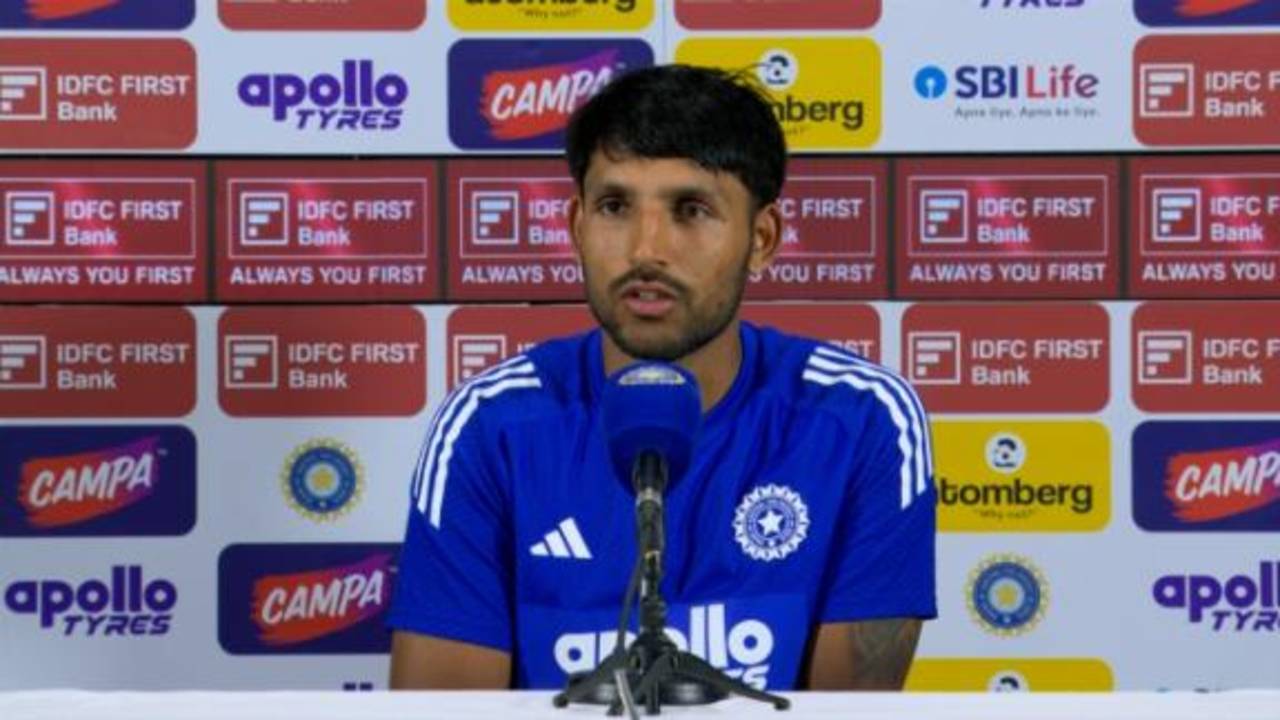Dhruv Jurel's square-of-the-wicket artistry
The wicketkeeper-batter shows his full range during a maiden Test hundred of uninterrupted poise
Karthik Krishnaswamy
03-Oct-2025
In the course of going from 36 to 60 on Friday afternoon in Ahmedabad, Dhruv Jurel hit three fours off West Indies' seamers. He hit all three off the back foot, all three in the arc behind square on the off side, and each was subtly different from the other.
The first came off a Jayden Seales delivery that was short but not necessarily wide, rising to just below shoulder height. Jurel rose with the ball, leaning slightly backwards to create room, and met it below his chin with his bat face open, using all of Seales' pace to guide the ball wide of gully.
The second and third came off Justin Greaves, and while there was a little more width to work with on these occasions, there wasn't as much pace, so Jurel manufactured the power himself, with two distinct kinds of wristwork. First, the conventional back-cut with wrists imparting topspin; here the emphasis was on getting on top of the bounce and keeping the ball down. The next one didn't bounce quite as much, so Jurel was able to employ the slice - with the point fielder having been pushed back, this way of playing the shot ensured he had no chance of saving the boundary, with the ball curving further and further away to his left as it scudded over the outfield.
These weren't particularly difficult shots for a Test batter to execute in excellent batting conditions, particularly against a bowler of Greaves' pace limitations. They made for gorgeous watching, though, particularly for viewers invested in Indian cricket's vast talent pool. We have watched Jurel bat and score runs before, and we've watched him do it in Test cricket, but we hadn't really had the chance of seeing this facet of his game, this deft, square-of-the-wicket artistry.
The innings that made everyone sit up and take notice of Jurel, the match-turning 90 against England in Ranchi last year, had come on a pitch of treacherous low bounce that all but took square-of-the-wicket runs out of the equation. That innings had been all about the full face of the bat and the opportunism of pouncing on scoring opportunities down the ground.
This innings, a maiden Test hundred of uninterrupted poise in straightforward batting conditions, allowed Jurel to show off his full square-of-the-wicket range. You could admire the fleetness of his footwork when he pulled Roston Chase for six when the offspinner dropped marginally short. From watching him do it again and again, you could marvel at his ability to place his leg-side clips exactly where he wanted, square or even behind square, without needing to close the face of his bat, just by meeting the ball a little closer to his body or a little further away.
It all looked so calm and organised that you began to forget this was a man playing just the sixth Test match of an understudy's career, all but one of his chances having arrived thanks to injury to one of the game's great wicketkeeper-batters. You began to forget that he had never before batted as high as No. 5.
But Jurel has always had this effect on the viewer, with that confident strut to the crease, that compact technique - with his hands never seeming to stray too far from his body, from backlift to follow-through - and those light feet that never seem to move all that much but usually seem to be in the right place. "Relax," all of that tells you. "I know what I'm doing."
He makes this look effortless, but it could be the outcome of the rigorous mental preparation he does before matches, visualising all the scenarios he's likely to come up against - the bowlers, the fields they are likely to set, the gaps he can target, the areas where he can score risk-free runs. And he does all this even when he knows he's not playing.
"I visualise a lot, whether I'm playing or not - I visualise what I would be doing if I was playing," he said at the end of the second day's play in Ahmedabad. "When I do play a match, nothing feels new to me. It feels like I've already experienced it, and I know what the feeling is.
"Everything I visualise - walking in, taking stance, taking leg [stump] guard, everything I visualise, so nothing feels different. I'm always prepared, whether I'm playing or not playing, I make that effort to keep myself ready."
So far, Jurel has had to keep himself ready for opportunities that could come without warning, but the assurance he radiates every time he keeps wicket and bat will surely lead India's team management to consider playing him regardless of Rishabh Pant's availability, with one of them keeping and the other playing as a specialist batter.
That discussion is gaining volume, but Jurel isn't about to get drawn into it.
"I feel you control what's in your control. It's not my decision whether I'm played as a batter or as a keeper. Wherever I get to play a match, whether it's [international or] domestic, my job is to score runs."
For the moment, he's doing that as well as he possibly can.
Karthik Krishnaswamy is an assistant editor at ESPNcricinfo

